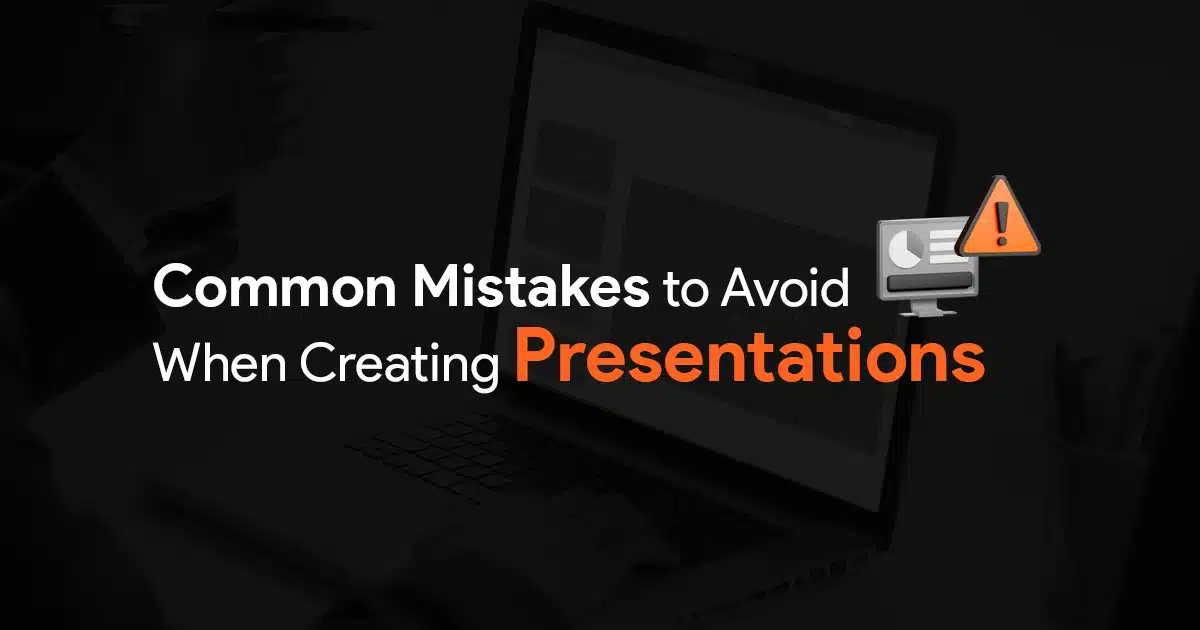- Table of contents
- 6 Presentation Mistakes to Avoid
- How to Plan a Clear Structure For your Presentations
- How to Avoid Using Too Much Text in Your Presentations?
- How to Find The Right Font Size For Your Presentations?
- How to Avoid Using Too Many Colors in Your Presentations?
- How to Practice Presentations?
- How to Engage Your Audience During Your Presentations?
6 Mistakes to Avoid When Creating Presentations: Insider Tips for Success

Creating an impactful and successful presentation requires careful planning and attention to detail. There are many mistakes that can affect the effectiveness of a presentation. Let’s discuss six of the most common presentation mistakes you can avoid when creating presentations.
Table of contents
- 6 Presentation Mistakes to Avoid
- How to Plan a Clear Structure For your Presentations
- How to Avoid Using Too Much Text in Your Presentations?
- How to Find The Right Font Size For Your Presentations?
- How to Avoid Using Too Many Colors in Your Presentations?
- How to Practice Presentations?
- How to Engage Your Audience During Your Presentations?
6 Presentation Mistakes to Avoid
Here are the most common mistakes you might make while creating presentations, and what you can do to avoid them:
Not having a clear structure
This is one of the most common mistakes people make when creating presentations. It’s important to have a clear and logical structure to your presentation. Having a clear structure to your presentations will help your audience follow along and understand your message. To avoid this mistake you must create an outline or mind map to plan the flow of your presentation. Doing this alone can make your presentation more effective. If you need to learn more about working on the structure of a presentation, keep reading, we’ve covered that in this article too.
Using too much text
A slide with too much text is an eyesore. Overcrowding your slides with text can make it overwhelming and difficult for your audience to understand your presentation. To avoid this mistake, use bullet points or short phrases instead of full sentences, and use visual aids like images and graphs to supplement your message.
Using a small font size
Using a small font size in your presentations is another common mistake. The text can be hard to read, especially if your audience is seated far from the screen. To avoid this mistake, use a font size that is large enough to be easily readable from a distance.
Using too many colors
Using too many colors can be distracting and make your presentation look cluttered. To avoid this mistake, use a limited color palette and choose colors that complement each other.
Not practicing
Not practicing your presentation can lead to mistakes and a lack of confidence when presenting. To avoid this mistake, practice your presentation beforehand and consider rehearsing in front of a friend or colleague to get feedback.
Not engaging your audience
It’s important to engage your audience and keep their attention throughout your presentation. To avoid this mistake, use interactive elements such as questions and polls, and vary your delivery by speaking at different speeds and using different tones.
Let’s dive into some common issues and have a look at how to solve them in detail:
How to Plan a Clear Structure For your Presentations
Here are some steps you can follow to plan a clear structure for your presentations:
- Identify your main message: What is the main point you want to convey to your audience? This will be the foundation of your presentation and should be the focus of each of your slides.
- Create an outline: Start by listing out the key points you want to cover in your presentation. You can then group these points into logical sections and arrange them in a logical order.
- Use headings and subheadings: Use headings and subheadings to help your audience follow the structure of your presentation and identify the main points you want to convey.
- Use visual aids: Visual aids such as images, charts, and graphs can help to clarify your message and make it easier for your audience to understand. Use them to supplement your text and help illustrate your points.
- Practice your delivery: Practice your presentation to ensure that you are comfortable with the flow and pacing of your delivery. This will help you to deliver your message clearly and confidently.
- Review and revise: Review your presentation and make any necessary revisions to ensure that it is clear, concise, and effective. Overall, a clear structure is essential for a successful presentation, as it helps your audience understand your message and follow along with your content.
How to Avoid Using Too Much Text in Your Presentations?
Here are some tips for avoiding using too much text in your presentations:
- Use bullet points: Rather than using full sentences, use bullet points to highlight key points and ideas. This will make it easier for your audience to read and understand your message.
- Use images and graphics: Visual aids such as images and graphics can help to illustrate your points and break up large blocks of text.
- Use short phrases: Use short phrases and concise language rather than long, wordy sentences. This will make it easier for your audience to follow along and retain your message.
- Use white space: Use white space effectively by leaving plenty of empty space on your slides. This will make your slides easier to read and less cluttered.
- Edit and revise: Review your slides and cut any unnecessary text. It’s better to have fewer slides with more focused content than a large number of densely packed slides.
By following these tips, you can create slides that are easy to read and understand, and avoid overwhelming your audience with too much text.
How to Find The Right Font Size For Your Presentations?
Here are some tips for finding the right font size for your presentations:
- Consider your audience: If your audience will be seated far from the screen, you’ll need to use a larger font size to ensure that it is easily readable. On the other hand, if your audience will be seated close to the screen, you may be able to use a smaller font size.
- Test your font size: Before giving your presentation, test the font size by standing at the back of the room or by projecting the slides onto a larger screen. This will give you an idea of how legible the font size is from a distance.
- Use a consistent font size: Use a consistent font size throughout your presentation to avoid confusion and maintain a professional look.
- Use a font size that is easy to read: A good rule of thumb is to use a font size that is at least 16 points for body text and 24 points or larger for headings.
How to Avoid Using Too Many Colors in Your Presentations?
Here are some tips for avoiding using too many colors in your presentations:
- Use a limited color palette: Choose a limited number of colors to use throughout your presentation. This will help to create a cohesive look and avoid a cluttered or chaotic appearance.
- Choose colors that complement each other: When selecting colors, choose shades that complement each other and create a cohesive look. For example, you might choose one or two main colors and use variations of those colors throughout your presentation.
- Use color to highlight key points: Rather than using a different color for every element on your slides, use color sparingly to highlight key points or draw attention to important information.
- Use neutral colors for backgrounds: Use neutral colors such as white, black, or gray for your slide backgrounds. This will help to create a clean and professional look, and allow your content to stand out.
By following these tips, you can use color effectively in your presentations without overwhelming your audience or creating a cluttered appearance. Overall, using a limited color palette and choosing colors that complement each other can help to create a cohesive and professional-looking presentation.
How to Practice Presentations?
Here are some tips for practicing your presentations:
- Rehearse your presentation: Rehearse your presentation out loud to get a sense of the flow and pacing. This will help you to become more comfortable with your material and improve your delivery.
- Time yourself: Time yourself to ensure that your presentation fits within the allotted time frame. This will help you to avoid running over or rushing through your material.
- Practice in front of a mirror: Practice your presentation in front of a mirror to get a sense of your body language and facial expressions. This will help you to identify any nervous habits or awkward gestures and work on improving them.
- Practice in front of a friend or colleague: Practice your presentation in front of a friend or colleague to get feedback on your delivery and content. This can help you to identify areas for improvement and make any necessary revisions.
- Record yourself: Consider recording yourself as you practice your presentation. This will allow you to review your delivery and identify any areas for improvement.
By following these tips, you can practice your presentation effectively and improve your delivery. Overall, practicing your presentation is an important step in ensuring that you feel confident and prepared when presenting to your audience.
If you’re someone who gets nervous during presentations, check out this article.
How to Engage Your Audience During Your Presentations?
Here are some tips for engaging your audience during your presentations:
- Use interactive elements: Use interactive elements such as questions and polls to engage your audience and encourage participation. This can help to keep their attention and make your presentation more interactive and dynamic.
- Use storytelling: Use storytelling techniques to make your presentation more engaging and memorable. Tell a story that relates to your topic, and use anecdotes and examples to illustrate your points.
- Use visual aids: Use visual aids such as images, charts, and graphs to supplement your message and help illustrate your points. This can help to keep your audience’s attention and make your content more engaging.
- Vary your delivery: Vary your delivery by speaking at different speeds and using different tones. This can help to keep your audience’s attention and make your presentation more dynamic.
- Encourage audience participation: Encourage your audience to ask questions and participate in discussions to keep them engaged and invested in your presentation.
In conclusion, creating a successful presentation requires careful planning and attention to detail. By avoiding common presentation mistakes such as a lack of structure, using too much text, using a small font size, using too many colors, not practicing, and failing to engage your audience, you can ensure that your presentation is effective and well-received. By following these tips, you can deliver a presentation that is informative, engaging, and memorable.


